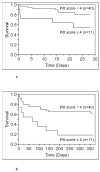Incidence of Pseudomonas aeruginosa bacteremia: a population-based study
- PMID: 18691484
- PMCID: PMC2615391
- DOI: 10.1016/j.amjmed.2008.03.029
Incidence of Pseudomonas aeruginosa bacteremia: a population-based study
Abstract
Background: The incidence of Pseudomonas aeruginosa bacteremia has not been defined in a population-based investigation.
Methods: We performed a retrospective, population-based incidence study using resources of the Rochester Epidemiology Project of Olmsted County, Minnesota. We identified all Olmsted County residents with P. aeruginosa bacteremia between January 1, 1997, and December 31, 2006, by microbiology records in the only 2 laboratories in the county. Medical records were reviewed to confirm diagnosis, residency status, and clinical characteristics.
Results: Age-adjusted incidence per 100,000 person-years was 10.8 (95% confidence interval [CI], 7.5-14.0) in men and 3.7 (95% CI, 2.2-5.2) in women for total P. aeruginosa bacteremia, and 8.4 (95% CI, 5.5-11.2) in men and 2.5 (95% CI, 1.3-3.8) in women for monomicrobial P. aeruginosa bacteremia. There was no significant change in incidence of total P. aeruginosa bacteremia during the past decade (P=.418). Incidence increased exponentially with age, with a greater magnitude of increase in men compared with women for total and monomicrobial P. aeruginosa bacteremia (P=.007 and P=.015, respectively). In patients with monomicrobial P. aeruginosa bacteremia, the median age was 69 years, and 78.4% of cases were either nosocomial or health care associated. Most patients had multiple comorbid conditions. The urinary tract was the most common primary source of infection. The 28-day all-cause mortality of monomicrobial P. aeruginosa bacteremia was 25.5%. In vitro susceptibility to ciprofloxacin was 95.3%.
Conclusion: To our knowledge, this is the first population-based incidence study of P. aeruginosa bacteremia. The incidence of P. aeruginosa bacteremia has remained stable during the past decade. Fluoroquinolone susceptibility is high among local P. aeruginosa bacteremia isolates.
Conflict of interest statement
Figures



References
-
- Pier GB, Ramphal R. Pseudomonas aeruginosa. In: Mandell GL, Bennett JE, Dolin R, editors. Principles and Practice of Infectious Diseases. 6. Vol. 2. Philadelphia, PA: Elsavier Churchill Livingstone; 2005. pp. 2587–2615.
-
- Diekema DJ, Pfaller MA, Jones RN, et al. Survey of bloodstream infections due to gram-negative bacilli: frequency of occurrence and antimicrobial susceptibility of isolates collected in the United States, Canada, and Latin America for the SENTRY Antimicrobial Surveillance Program, 1997. Clin Infect Dis. 1999;29(3):595–607. - PubMed
-
- Friedland I, Gallagher G, King T, Woods GL. Antimicrobial susceptibility patterns in Pseudomonas aeruginosa: data from a multicenter Intensive Care Unit Surveillance Study (ISS) in the United States. J Chemother. 2004;16(5):437–41. - PubMed
-
- US Census Bureau. Olmsted County QuickFacts. http://quickfacts.census.gov/qfd/states/27/27109.html.
Publication types
MeSH terms
Grants and funding
LinkOut - more resources
Full Text Sources
Miscellaneous

